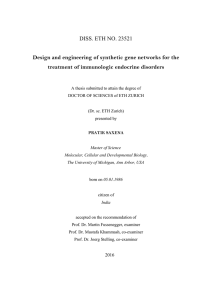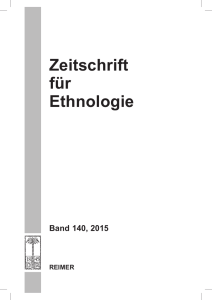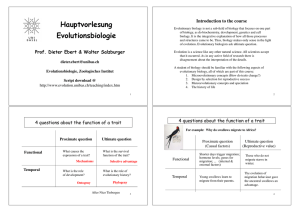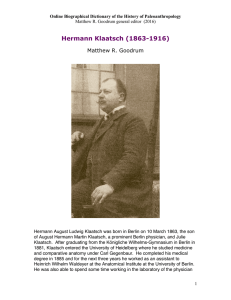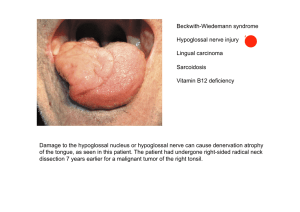hemangiopericytoma
Werbung
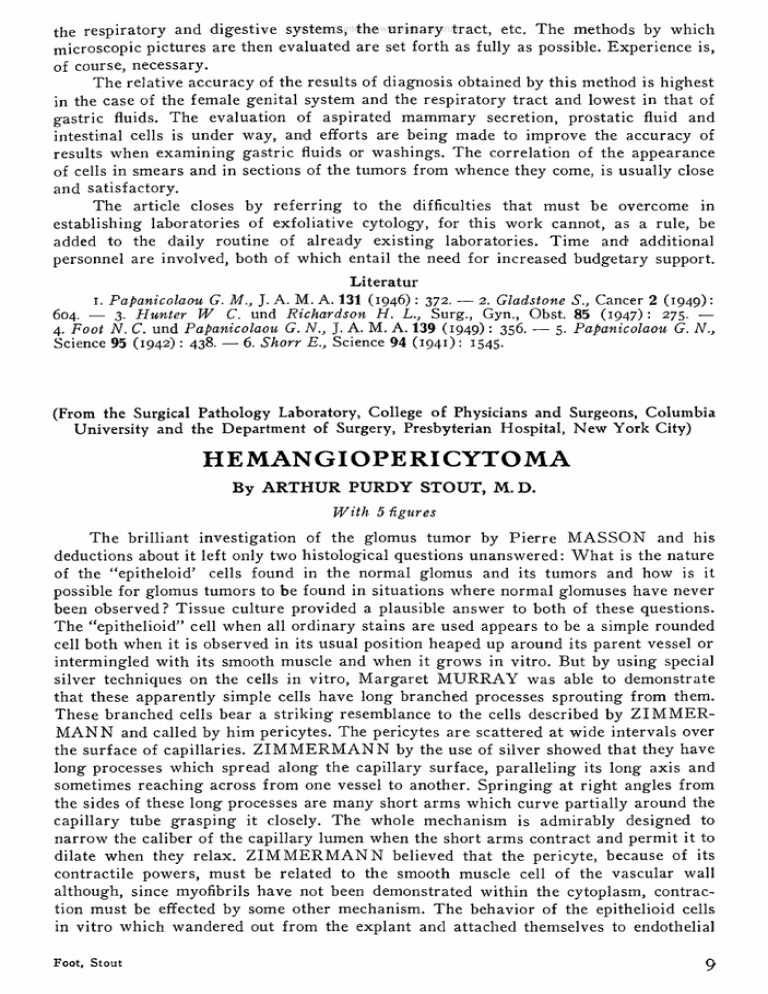
download unter www.biologiezentrum.at the respiratory and digestive systems, the urinary tract, etc. The methods by which microscopic pictures are then evaluated are set forth as fully as possible. Experience is, of course, necessary. The relative accuracy of the results of diagnosis obtained by this method is highest in the case of the female genital system and the respiratory tract and lowest in that of gastric fluids. The evaluation of aspirated mammary secretion, prostatic fluid and intestinal cells is under way, and efforts are being made to improve the accuracy of results when examining gastric fluids or washings. The correlation of the appearance of cells in smears and in sections of the tumors from whence they come, is usually close and satisfactory. The article closes by referring to the difficulties that must be overcome in establishing laboratories of exfoliative cytology, for this work cannot, as a rule, be added to the daily routine of already existing laboratories. Time and1 additional personnel are involved, both of which entail the need for increased budgetary support. Literatur i. Papanicolaou G. M J. A. M. A. 131 (1946): 372. — 2. Gladstone S., Cancer 2 (1949): 604. — 3. Hunter W C. und Richardson H. L., Surg., Gyn., Obst. 85 (1947): 275. — 4. Foot N. C. und Papanicolaou G. N.} J. A. M. A. 139 (1949) : 356. — 5. Papanicolaou G. N., Science 95 (1942) : 438. — 6. Shorr E.t Science 94 (19 4 1) : 1545- (From the Surgical Pathology Laboratory, College of Physicians and Surgeons, Columbia University and the Department of Surgery, Presbyterian Hospital, New York City) H EM A N G IO PERICYTO M A By A R T H U R P U R D Y STOUT, M . D . With 5 -figures The brilliant investigation of the glomus tumor by Pierre M A SS O N and his deductions about it left only two histological questions unanswered: W hat is the nature of the “ epitheloid’ cells found in the normal glomus and its tumors and how is it possible for glomus tumors to be found in situations where normal glomuses have never been observed? Tissue culture provided a plausible answer to both of these questions. The “ epithelioid” cell when all ordinary stains are used appears to be a simple rounded cell both when it is observed in its usual position heaped up around its parent vessel or intermingled with its smooth muscle and when it grows in vitro. But by using special silver techniques on the cells in vitro, M argaret M U R R A Y was able to demonstrate that these apparently simple cells have long branched processes sprouting from them. These branched cells bear a striking resemblance to the cells described by Z IM M E R M A N N and called by him pericytes. The pericytes are scattered at wide intervals over the surface of capillaries. Z IM M E R M A N N by the use of silver showed that they have long processes which spread along the capillary surface, paralleling its long axis and sometimes reaching across from one vessel to another. Springing at right angles from the sides of these long processes are many short arms which curve partially around the capillary tube grasping it closely. The whole mechanism is admirably designed to narrow the caliber of the capillary lumen when the short arms contract and permit it to dilate when they relax. Z IM M E R M A N N believed that the pericyte, because of its contractile powers, must be related to the smooth muscle cell of the vascular wall although, since myofibrils have not been demonstrated within the cytoplasm, contrac­ tion must be effected by some other mechanism. The behavior of the epithelioid cells in vitro which wandered out from the explant and attached themselves to endothelial Foot, Stout 9 unter www.biologiezentrum.at sprouts from the same source download coupled with the complex branches from these cells demonstrated by a modified Bodian silver impregnation left no doubt in the minds of M U R R A Y and the writer that the “ epithelioid” cells of the glomus tumor were the same as Z IM M E R M A N N s pericytes. Since pericytes are present on the surface of all capillaries, this observation permitted a credible explanation of the occurrence of glomus tumors in situations where normal glomuses have not been observed. The writer has long been interested in the tumors of mesodermal origin among which, of course, are the vascular tumors. Those tumors which are composed of differentiated capillaries, veins and arteries offer no particular difficulties and those vascular tumors both benign and malignant in which the endothelial cells play a dominant role are not too difficult to identify if one will take the trouble to make a silver reticulin impregnation which blackens the vascular reticulin sheath and shows the proliferated endothelial cells inside of that sheath. But this does not account for all vascular tumors. There are a certain number featured by a vast number of capillaries many of which may be in­ conspicuous because they are collapsed and one may only suspect their presence if their lining endothelial cells are sufficiently prominent to be noticed in ordinary stains. Packed tightly around the capillaries and filling in all of the space between them are massed cells whose shape varies from round to elongate. These tumors have remained unidentified and have been called by many names because the nature of their dominant cells has remained a mystery and usually the fact that they are basically vascular tumors has gone unrecognized. Since it is the custom in the writer’s laboratory to study all difficult diagnostic problem tumors with a silver reticulin impregnation, the vascular nature of these tumors has long been recognized because the silver blackens the capillary reticulin sheath and makes the vessels easily apparent. But the nature of the surrounding cells remained a mystery. They could hardly be endothelial cells because all of them were outside of the reticulin capillary sheath and the capillaries were lined with normal endothelial cells. A fter M U R R A Y had demonstrated the neoplastic potentialities of the pericyte, it occurred to the writer that perhaps the cells featuring this group of tumors might be related to pericytes in spite of the fact that morphologically their shapes often were quite variable. It seemed possible that the variations in shape might be explained by supposing that by assuming a spindle shape the neoplastic pericyte was exhibiting its relationship with the smooth muscle cell. A rather premature paper was published in 1942 in collaboration with M U R R A Y describing nine such cases, suggesting that the featuring cell was the pericyte and proposing the name hemangiopericytoma for these tumors. A year later a tenth case, brought to the attention of the writer by R E Z E K of Miami, Florida, was published in conjunction with C A S S E L . The writer hoped that other observers would study collections of similar tumors and criticize the hypothesis that.they are vascular tumors featuring pericytes. Since that hope has proved vain and new cases have accumulated, sent to the writer through the kindness of many friends, he determined to reexamine the group and as a result a collection of 25 additional cases have been studied. These together with the ten cases previously published form the basis for a new paper which will appear early in 1950 in the journal “ Cancer” These 35 cases, a large majority of which have been studied with Masson trichrome stains and Laidlaw silver reticulin impregnations show that the wide variation in the cellular appearance may be accounted for if one assumes that the pericytes are labile cells which on the one hand can closely imitate the appearance and arrangement of vascular smooth muscle cells and on the other hand can closely approximate the rounded aspect of the glomus tumor pericyte. In between, one can find tumors whose cells show all gradations of variation in size and shape between these two extremes. E very tumor is characterized by a proliferation of many capillaries with the cells in 10 Stout www.biologiezentrum.at question tightly packed around download them. unter Most of these 35 tumors proved benign. S ix of them, however, metastasized and seven others showed aggressive growth so that a third have demonstrated some degree of malignancy. The thesis might be regarded as settled if it had been possible to show charac­ teristic pericyte growth in vitro after explantation. Unfortunately only one tumor has been available for explantation and that one did not show a growth characteristic of pericytes. The cells grew profusely in vitro but M U R R A Y has been unable to identify them; at least they have not shown the exact characteristics of endothelium, fibroblasts, leiomyocytes, or anything else which she can recognize. Thus the attempt to identify the cells as definite pericytes in this one case has failed, but since they have not been proved to be anything else, this test can only be regarded as inconclusive. The writer feels convinced that these tumors form an entity belonging to the vascular group. The suggestion that their characteristic cells are pericytes remains an hypothesis unsupported by proof. Since it is necessary to call them by some name, and since it is possible that the featuring cells may be modified pericytes, it is suggested that the name hemangiopericytoma be retained for the present. It can be abandoned later if they prove to have some other derivation. Zusammenfassung Pierre M A SS O N s Untersuchungen über den Glomustumor ließen die Frage über das Wesen der epitheloiden Zellen des normalen Glomus und der seiner Geschwülste sowie über das Vorkommen von Glomustumoren in unter normalen Umständen glomusfreien Regionen offen. Bei Anwendung einer bestimmten Silbertechnik an Gewebskulturen konnte M ar­ garet M U R R A Y den Nachweis erbringen, daß die „epitheloiden“ Zellen auffallende Ähnlichkeit mit den von Z IM M E R M A N N beschriebenen Perizyten aufwiesen. Ge­ nannte Autorin glaubte nach Anwendung der Bodianschen Silberimprägnation die Identität beider Zellformen bewiesen zu haben. Die Beobachtung, daß Perizyten auf allen Kapillaroberflächen vorhanden sind, ermöglichte das Verstehen des Vorkommens von Glomustumoren unter Bedingungen, wo sonst normalerweise Glomi nicht vor­ handen sind. V erfasser, seit längerem an dem Problem mesodermaler Tumoren, auch solcher vaskulären Aufbaues, besonders interessiert, glaubt diese mehr oder weniger leicht identifizieren zu können, sofern eine entsprechende Technik angewendet wird. Diese Behauptung erfährt jedoch, ST O U T s Ausführungen folgend, gewisse Einschränkungen. Es gibt eine Reihe von Tumoren, deren kapillärer Aufbau durch Kollaps der Gefäß­ lichtungen verschleiert wird und deren wahre Natur (Identifizierung ihres Endothels als solches) bei Gebrauch einer bestimmten Technik gelegentlich erkannt wird. E r ­ schwert wird die richtige Agnoszierung dieser Geschwülste noch durch den Umstand, daß zwischen den kollabierten Kapillarschlingen Zellanhäufungen vorhanden sind, deren runde oder in die Länge gezogene Begrenzung das ohnehin komplizierte Bild noch mehr verschleiert. Diese Geschwülste, in ihrer richtigen Natur oft unerkannt oder miß­ deutet, laufen unter den verschiedensten Bezeichnungen. Silberimprägnationen lassen die kapilläre Retikulumscheide als solche und damit die Gefäßwand leicht erkennen. Diese Erkenntnis löste aber nicht das Rätsel der die Kapillaren umgebenden Zell­ komplexe, da sie außerhalb des Kapillarretikulums lagen und die normalen K apillarendothelien leicht darstellbar waren. Gestützt auf die Befunde M argaret M U R R A Y s, wonach den Perizyten tumor­ bildende Eigenschaften zugeschrieben werden können, glaubt der V erfasser, die früher erwähnten extrakapillaren Zellmassen, trotzdem sie manchmal auch längliche Gestalt annehmen und so an Gefäßmuskelzellen erinnern, als Perizyten ansehen zu können Stoul download unter www.biologiezentrum.at und bezeichnet diese Tumoren als Hämangioperizytome. E s war ihm möglich, bis 1943 zehn einschlägige Fälle zu beschreiben, doch bereicherte sich seither die Zahl seiner Beobachtungen durch 25 neu hinzugekommene. Eine genaue Analyse aller 35 Fälle wird vom V erfasser für die nahe Zukunft angekündigt. Alle diese Tumoren zeigten starke Kapillarproliferation, umgeben von den be­ schriebenen Zellanhäufungen außerhalb der Schlingen. Die meisten der beobachteten Fälle waren gutartig, sechs unter ihnen metastasieren jedoch und sieben zeigten aggressives Wachstum, so daß ein Drittel der Fälle als malign anzusprechen ist. Das Problem wäre als gelöst zu betrachten, wenn es möglich gewesen wäre, charakteristische Perizyten nach Explantation in Gewebskulturen zu züchten. Der Versuch konnte nur in einem Falle angestellt werden und fiel negativ aus, das heißt, der Tumor wuchs profus, aber die einzelnen Zellen konnten nicht ihrer A rt ent­ sprechend identifiziert werden; doch konnte auch nicht erwiesen werden, daß man es nicht mit Perizyten zu tun habe. V erfasser ist nach wie vor überzeugt, daß diese Tumoren in ihrer Gesamtheit der Gefäßtumorengruppe zuzurechnen sind. Ihre Zusammensetzung aus Perizyten ist noch nicht bewiesen, kann jedoch nicht ausgeschlossen werden. Mangels einer anderen besseren Bezeichnung schlägt V erfasser daher vor, bis auf weiteres für diese A rt von Geschwülsten den Namen Hämangioperizytom beizubehalten. Ph. Rezek, Miami. Bibliography Murray M. R., and Stout A. P., Am. J. Path. (1942): 183— 194. — Stout A. P., Hem­ angiopericytoma. Cancer 2 (1949): 1027— 1054. — Stout A. P., and Cassel C., Surgery 13 (: 943) •’ S78—581. — Stout A. P., and Murray M. R., Ann. Surg. 116 (1942): 26—33. ■— Zimmermann K. W Z. Anat. Entwicklungsgesch. 68 (1923): 29— 109. Fig. 1. Hemangiopericytoma imitating the appearance of a venous hemangioma but without any myofibrils in the cells. The vessels are lined with normal endothelial cells (515 :1). 12 Stoat download unter www.biologiezentrum.at Fig. 2 . Laidlaw silver reticulin impregnation of the tumor shown in Fig. 1, showing that the cellular proliferation has been altogether outside of the vascular reticulin sheath (515 1). Fig. 3. Hemangiopericytoma of the tongue. Recurrence following excision of a non-encapsulated tumor. The many vessels have normal endo­ thelial lining. The tumor cells are rounded and packed tightly around the vessels thus imitating the appearance of a glomus tumor but without its organoid arrangement of tissues (515 :1). download unter www.biologiezentrum.at Fig. 4 . Laidlaw silver reticulin impregnation of the tumor shown in Fig. 3 showing that the cellular proliferation is altogether outside of the reticulin sheaths of the many capillaries (515 1). I 'ig . 5. Malignant hemangiopericytoma of the retroperitoneum. A t the left is the tumor stained with H. and E. The capillaries are all collapsed and can only be distinguished by their swollen endothelial cells. The polymorphous tumor cells are tightly packed between the vessels. A t the veight a Laidlaw silver reticulin impregnation showing the great number of capillaries easily recognized because their sheaths are blackened. A ll cellular proliferation has occured outside of these sheaths (515:1).


